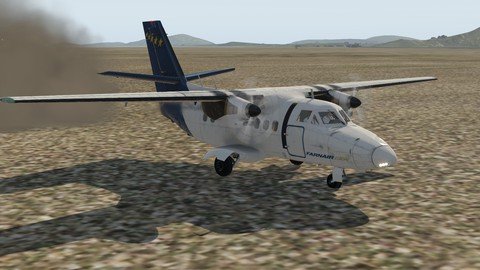

E-Books / Video Training →Udemy - Flying Different Aircraft Types
Published by: voska89 on 6-01-2022, 18:44 |  0
0

MP4 | Video: h264, 1280x720 | Audio: AAC, 44.1 KHz
Language: English | Size: 2.45 GB | Duration: 1h 55m
Lots of different aircraft for you to apply what you learned on the Cessna 172 course.
What you'll learn
Learning to fly
Requirements
Learn how to fly aircraft the easy way and the cheap way.
Description
If it is your aim to become a commercial pilot. Learn online how to fly the Cessna 172 and then apply what I taught you in the course to other aircraft especially twin engine types which are the backbone of civil aviation. Here are some examples most are free downloads and some are not. It is important to get the feel of different types and to know how to get the feel of a new aircraft quickly.
International Regulation Type ratings are required for aircraft over 5700kgs
Flag of the ICAO
The International Civil Aviation Organization (ICAO) specifies the international personnel licensing requirements, as documented in Annex 1 to the Convention on International Civil Aviation. Which aircraft require a type rating is decided by the National Aviation Authority, in accordance with specifications outlined by ICAO.
ICAO stipulates that
Type Ratings should be established for aircraft with minimum crew of at least two pilots
or when considered necessary by the Licensing Authority
The applicant for a Type Rating must demonstrate the degree of skill required - including all normal flight procedures, emergency procedures, instrument procedures (where applicable) as well as upset prevention and recovery.
In many countries pilots of single-engined aircraft under a certain maximum weight (5,700 kg or 12,500 lb, typically) do not require a type rating for each model, all or most such aircraft being covered by one class rating instead. There are exceptions to this, e.g. under the European Joint Aviation Authorities (JAA) regulations the piston version of the Piper Malibu does require its own type rating. In New Zealand and South Africa there is no class rating, each aircraft model requires its own rating. Countries which have adopted the class rating system for small aircraft typically require additional training and license endorsement for complexity features such as conventional undercarriage (tailwheels), variable-pitch propellers, retractable undercarriage, etc.
Many commercial aircraft share type ratings, allowing qualified pilots to operate both of them with minimal transition training. Examples include the Boeing 757 and Boeing 767, Boeing 777 and Boeing 787, Airbus A330 and Airbus A340, and all of the members of the A320 family (the A318, A319, A320, and A321).
Who this course is for
All levels of experiance
Homepage
https://www.udemy.com/course/now-try-your-hand-at-flying-different-types-of-aircraft/Buy Premium From My Links To Get Resumable Support,Max Speed & Support Me
https://hot4share.com/agaw6f17yc2l/1dj07.F.d.a.t..part1.rar.html
https://hot4share.com/hqbarwje8c97/1dj07.F.d.a.t..part2.rar.html
https://hot4share.com/4i7vvgnv0l8g/1dj07.F.d.a.t..part3.rar.html

https://uploadgig.com/file/download/de40140a57dc028d/1dj07.F.d.a.t..part1.rar
https://uploadgig.com/file/download/9bE4cF36a6e016d3/1dj07.F.d.a.t..part2.rar
https://uploadgig.com/file/download/a62b17e7eDeAB661/1dj07.F.d.a.t..part3.rar

https://rapidgator.net/file/8ad735531417bde42b14d25a4600deed/1dj07.F.d.a.t..part1.rar.html
https://rapidgator.net/file/b909e89ec05482c3c65206a762a33ebc/1dj07.F.d.a.t..part2.rar.html
https://rapidgator.net/file/77f37c5cf6d863dc30220697aeca5e49/1dj07.F.d.a.t..part3.rar.html

http://nitro.download/view/1F25E80FBC54C18/1dj07.F.d.a.t..part1.rar[/url]
http://nitro.download/view/BF4160961947F1A/1dj07.F.d.a.t..part2.rar[/url]
http://nitro.download/view/EAB4F95CFBD04E3/1dj07.F.d.a.t..part3.rar[/url]
Links are Interchangeable - No Password - Single Extraction
Related News
-
{related-news}

